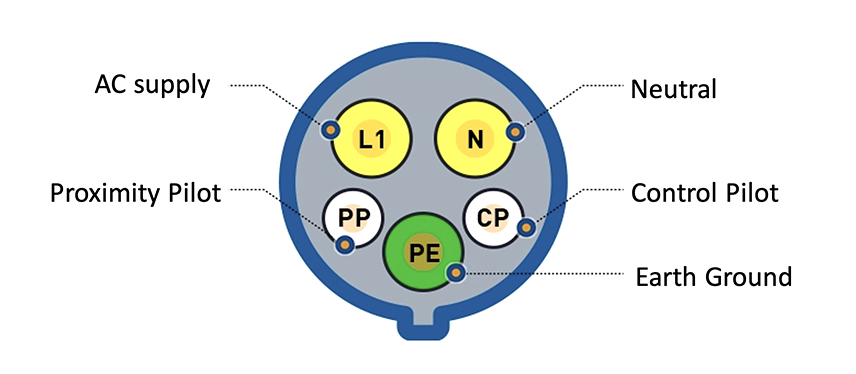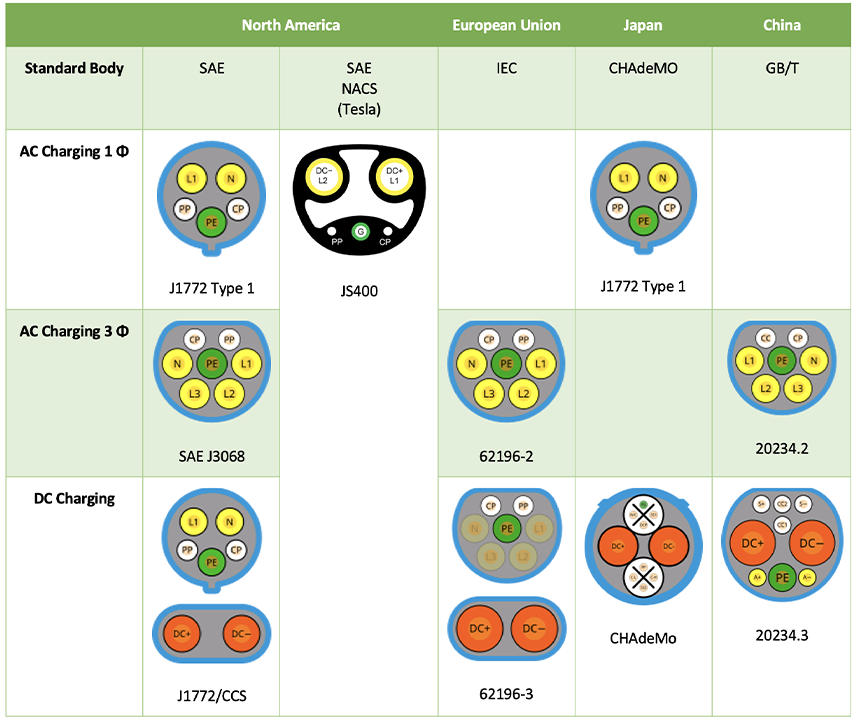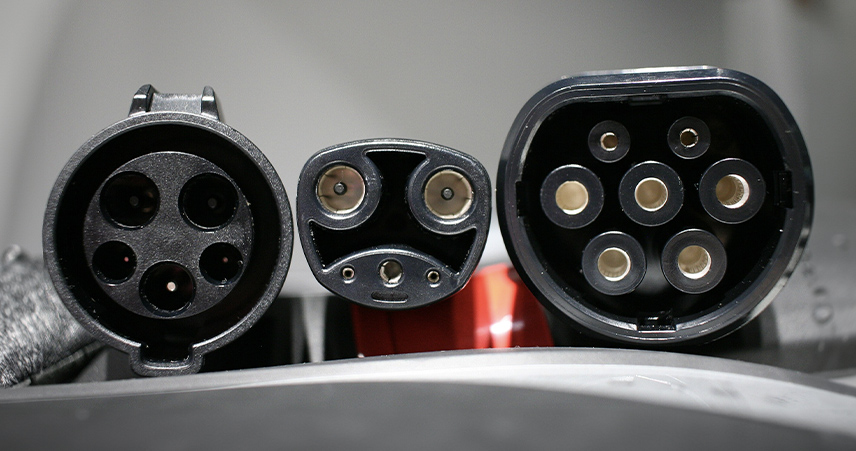
The ISO 15118 standard defines the power and communication interface between a battery-powered electric vehicle (BEV) or plug-in hybrid electric vehicle (PHEV) and the electric vehicle supply equipment (EVSE), the charger or charging station. Multiple documents comprise the standard. The ISO 15118-20 standard, an update of the ISO 15118-2 standard, defines the communication protocol between the EV and the EVSE. The standard enables internet protocol-based communication between the EV and the EVSE. The OSI layers that the standard defines include OSI layer 3, the network layer, and OSI layer 7, the application layer. The full name for the standard is:
ISO 15118-20:2022 Road vehicles – Vehicle to grid communication interface Part 20: 2nd generation network layer and application layer requirements.
Key features that facilitate convenient, secure, and efficient charging include:
- Plug & charge (PnC) seamless authentication and billing – allows automatic identification, authentication, and billing.
- Secure communication using encrypted data exchange – prevents user information from unauthorized access.
- Bidirectional energy flow – flows to the vehicle for charging and back to the power grid for load balancing and energy storage.
- Dynamic power management – enables the EV to request a specific charging power based on the state of the battery, the power capacity of the EVSE, and demand on the grid.
- Smart charging for load management – includes charge scheduling and modifying the charging rate based on grid conditions and use of renewable energy to optimize energy use and reduce costs.
- Cross-manufacturer compatibility – provides interoperability between different manufacturer’s EVs and charging stations.
- Support for fleet operations – provides centralized control over multiple vehicles’ charging sessions and roaming across different charging networks.
- Scalability and extensibility – allows future updates and new features, including new types of vehicles, charging methods, and energy services.
Multiple standards define the connector requirements for EV charging, as each manufacturing region has its own connector standards. These standards enable the implementation of the features described in ISO 15118-20. The standards describe connectors for use in both AC and DC charging systems. However, in almost all cases, the AC and DC connectors are different and incompatible with both charge modes. The following paragraphs describe the various connectors. Table 1 shows the form factor and the pinouts for all the connectors.
Connectors for AC charging stations
The Society of Automotive Engineers (SAE) developed a specific connector for AC EVSEs. The SAE J1772 standard defines a type 1 connector with five connections (Figure 1). Two receptacles carry the AC hot and neutral power lines. The third receptacle is earth ground. The fourth connection, the Proximity Pilot, ensures charging safety by providing a signal path to prevent drivetrain movement during charging and initiates a controlled charger shutdown prior to removing the charger connector. The fifth connection, the Control Pilot, passes signals that regulate and control the charging process. Charging is inoperative until the Control Pilot circuit is activated.
The J1772 type 1 connector for single-phase AC charging can support charging power up to 19.2 kW, delivering 240 V @ 80 A. The average charge rate in a Level 2 charging station can be as much as 25 – 30 miles of range/hour. This connector is primarily used in North America and Japan.

The European Union uses a variation of the Type 1 connector that is compliant with IEC 62196-2. It has two additional receptacles for three-phase AC power. The U.S. has a similar connector for 3-phase AC charging. The SAE J3068 standard defines this connector as the Type 2 connector. It can support up to 166 kW with up to 160 A.
Chinese EV and EVSE manufacturers use a connector that is compliant with the Chinese standard, GB/T 20234.2. This connector is a variant of the SAE J3068 Type 2 connector. The power pins of the Chinese connector are a mirror image of the U.S. and European Union Type 2 connectors.
Connectors for DC fast charging
Level 3 chargers use DC fast charging technology. DC charging can provide a number of advantages:
- High power delivery significantly reduces the time needed to charge an EV battery. Factors affecting charge time include the power rating of the charging station, the charging rate that the vehicle’s battery management system (BMS) will allow, and the battery capacity. Typically, DC fast charging stations can charge an EV to 80% of full charge in 20 – 40 minutes.
- ISO 15118-20 communication protocols between the charger and the EV BMS regulate the charging process. The communication ensures safe and efficient charging by monitoring the battery’s state-of-charge (SoC), temperature, and other parameters.
- User and EV safety features include overcurrent protection, insulation monitoring, and ground fault protection.
- Scalability supports higher power in the future.
Every region implements a unique version of the connector for DC charging.
Commercial EV charger connectors
North America
North American EV charger manufacturers have adopted the combined charging system (CCS) connector defined by the SAE as a J1772/CCS combination coupler. This connector adds two DC power receptacles to the J1772 Type 1 AC connector. The design is backward-compatible with AC-only charging stations so that one connector can provide either AC or DC charging. The CCS Type 1 connector can support charging rates up to 350 kW at voltages up to 1000 V and current levels up to 500 A.
The CCS Type 1 connector supports two basic types of communication to control the charging process. The first communication type is basic signaling, the same scheme used in AC charging systems. The second type is the high-level communication protocol that implements advanced ISO 15118 features such as vehicle-to-grid load sharing.
European Union
The European Union uses the IEC 62196-3 CCS Type 2 connector. This connector adds two DC receptacles to the IEC 62196-2 AC charging connector. Unlike the North American CCS Type 1 connector, the AC power connections are removed. As a result, the CCS Type 2 connector operates only with DC charging stations. The connector does support the same power, voltage, and current levels as the CCS Type 1 connector.
Japan
Japan has its own standard for DC charging connectors. The standard is called CHAdeMO, loosely translated as the charge for moving. The current standard implementation allows charging power up to 400 kW with as much as 1000 V and up to 400 A.
China
The connector Chinese EV and EVSE manufacturers use complies with China’s GB/T 20234.3 standard. The standard permits 250 kW EVSE power delivery at up to 1000 V and with up to 250 A. This connector is easily damaged. Thus, the Chinese and Japanese standards groups are working on a common new connector. The joint effort is called ChaoJi. The new connector will have proposed ratings of 900 kW, 1500 V, and 600 A. It will replace the GB/T DC and the CHAdeMO connectors, and, with adapters, the new connector will be backward compatible with both the two original connectors and CCS connectors.
Due to its market leadership, Tesla developed its own connector for EVs and EVSEs in the North American market. The SAE is standardizing the connector under SAE J3400. The connector is called the North American Charging System (NACS). Since Tesla charging stations are considered the most reliable and are the most prevalent in the North American market, most commercial EV charging station manufacturers have adopted the Tesla NACS connector. The NACS connector is smaller than the CCS Type 1 connector, as shown in Figure 3. The NACS connector can support AC charging at up to 80 A and 277 V. With DC fast charging, the connector can support up to 1000 V and greater than 650 A.


BTC POWER can ensure ISO 15118-compliant EV charging stations with appropriate connectors
The EV industry is relatively new and still evolving. New standards are in development. That creates challenges of compatibility and interoperability for EV and EVSE manufacturers. However, the ISO 15118-20 standard facilitates charging features such as plug & charge billing, encrypted communication, bidirectional energy flow, load management, and variable charging power. These features make charging more convenient, safer, and more efficient, and they will contribute to greater adoption of EVs.
New BTC POWER charging stations are ISO 15118-20 compliant. In addition, BTC POWER can provide guidance and customize its charging stations with any available charging connectors. Let BTC POWER help navigate the dynamic EV industry requirements and build customized charging stations for all customer requirements. Learn more about BTC commercial EV chargers and capabilities.

